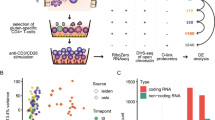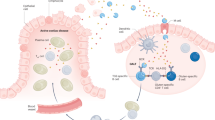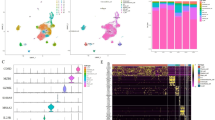Abstract
Coeliac disease (CD) is a complex genetic disorder. Its etiology is owing to multiple genes and environmental factors, such as gluten. The first event in the pathogenesis of CD after the ingestion of gluten is the activation of a Th1 immune response that leads to villous atrophy. Although this immune response seems crucial to the disease's development, only the HLA-DQ2/DQ8 genes have been identified as causative immune genes related to CD. Recently, the activation of the transcription factor STAT1 and changes in its expression levels have confirmed the participation of the Janus kinase-signal transducer and activator of transcription pathway in CD. Furthermore, as the STAT-1 gene is a positional candidate located in the CELIAC3 locus on chromosome 2, we speculate that alterations in this gene could be primarily responsible for the aberrant immune response that characterizes CD. Based on this functional and genetic evidence, we investigated the primary contribution of STAT-1 to CD. We performed a comprehensive genetic association study using five tag SNPs fully covering the STAT-1 gene in a Dutch cohort of 355 independent CD cases and 360 healthy controls. Neither the alleles, nor the genotypes in the case–control genetic association studies, nor the haplotype analysis showed any association to the STAT-1 gene in the Dutch CD population. Our results do not point to a primary involvement of the STAT-1 gene in the Dutch CD population.
Similar content being viewed by others
Log in or create a free account to read this content
Gain free access to this article, as well as selected content from this journal and more on nature.com
or
References
Marsh MN : Gluten, major histocompatibility complex, and the small intestine. A molecular and immunobiologic approach to the spectrum of gluten sensitivity (‘celiac sprue’). Gastroenterology 1992; 102: 330–354.
Wapenaar MC, van Belzen MJ, Fransen JH et al: The interferon gamma gene in celiac disease: augmented expression correlates with tissue damage but no evidence for genetic susceptibility. J Autoimmun 2004; 23: 183–190.
Sollid LM : Coeliac disease: dissecting a complex inflammatory disorder. Nat Rev Immunol 2002; 2: 647–655.
Babron MC, Nilsson S, Adamovic S et al: Meta and pooled analysis of European coeliac disease data. Eur J Hum Genet 2003; 11: 828–834.
Van Belzen MJ, Meijer JW, Sandkuijl LA et al: A major non-HLA locus in celiac disease maps to chromosome 19. Gastroenterology 2003; 125: 1032–1041.
Bevan S, Popat S, Braegger CP et al: Contribution of the MHC region to the familial risk of coeliac disease. J Med Genet 1999; 36: 687–690.
Sollid LM : Molecular basis of celiac disease. Annu Rev Immunol 2000; 18: 53–81.
Mazzarella G, MacDonald TT, Salvati VM et al: Constitutive activation of the signal transducer and activator of transcription pathway in celiac disease lesions. Am J Pathol 2003; 162: 1845–1855.
Monteleone G, Pender SL, Wathen NC, MacDonald TT : Interferon-alpha drives T cell-mediated immunopathology in the intestine. Eur J Immunol 2001; 31: 2247–2255.
Monteleone I, Monteleone G, Del Vecchio Blanco G et al: Regulation of the T helper cell type 1 transcription factor T-bet in coeliac disease mucosa. Gut 2004; 53: 1090–1095.
Woolley N, Mustalahti K, Maki M, Partanen J : Cytokine gene polymorphisms and genetic association with coeliac disease in the Finnish population. Scand J Immunol 2005; 61: 51–56.
Rioux JD, Karinen H, Kocher K et al: Genomewide search and association studies in a Finnish celiac disease population: identification of a novel locus and replication of the HLA and CTLA4 loci. Am J Med Genet A 2004; 130: 345–350.
Kristiansen OP, Larsen ZM, Pociot F : CTLA-4 in autoimmune diseases – a general susceptibility gene to autoimmunity? Genes Immun 2000; 1: 170–184.
van Belzen MJ, Mulder CJ, Zhernakova A, Pearson PL, Houwen RH, Wijmenga C : CTLA4 +49 A/G and CT60 polymorphisms in Dutch coeliac disease patients. Eur J Hum Genet 2004; 12: 782–785.
Zhernakova A, Eerligh P, Barrera P et al: CTLA4 is differentially associated with autoimmune diseases in the Dutch population. Hum Genet 2005; 118: 58–66.
Popat S, Hearle N, Hogberg L et al: Variation in the CTLA4/CD28 gene region confers an increased risk of coeliac disease. Ann Hum Genet 2002; 66: 125–137.
Revised criteria for diagnosis of coeliac disease: Report of working group of European society of paediatric gastroenterology and nutrition. Arch Dis Child 1990; 65: 909–911.
Hunt KA, McGovern DP, Kumar PJ et al: A common CTLA4 haplotype associated with coeliac disease. Eur J Hum Genet 2005; 13: 440–444.
Naluai AT, Nilsson S, Samuelsson L et al: The CTLA4/CD28 gene region on chromosome 2q33 confers susceptibility to celiac disease in a way possibly distinct from that of type 1 diabetes and other chronic inflammatory disorders. Tissue Antigens 2000; 56: 350–355.
Djilali-Saiah I, Schmitz J, Harfouch-Hammoud E, Mougenot JF, Bach JF, Caillat-Zucman S : CTLA-4 gene polymorphism is associated with predisposition to coeliac disease. Gut 1998; 43: 187–189.
Clot F, Fulchignoni-Lataud MC, Renoux C et al: Linkage and association study of the CTLA-4 region in coeliac disease for Italian and Tunisian populations. Tissue Antigens 1999; 54: 527–530.
Holopainen P, Arvas M, Sistonen P et al: CD28/CTLA4 gene region on chromosome 2q33 confers genetic susceptibility to celiac disease. A linkage and family-based association study. Tissue Antigens 1999; 53: 470–475.
King AL, Moodie SJ, Fraser JS et al: CTLA-4/CD28 gene region is associated with genetic susceptibility to coeliac disease in UK families. J Med Genet 2002; 39: 51–54.
King AL, Moodie SJ, Fraser JS et al: Coeliac disease: investigation of proposed causal variants in the CTLA4 gene region. Eur J Immunogenet 2003; 30: 427–432.
Mora B, Bonamico M, Indovina P et al: CTLA-4 +49 A/G dimorphism in Italian patients with celiac disease. Hum Immunol 2003; 64: 297–301.
Popat S, Hearle N, Wixey J et al: Analysis of the CTLA4 gene in Swedish coeliac disease patients. Scand J Gastroenterol 2002; 37: 28–31.
Martin-Pagola A, Perez de Nanclares G, Vitoria JC et al: No association of CTLA4 gene with celiac disease in the Basque population. J Pediatr Gastroenterol Nutr 2003; 37: 142–145.
Amundsen SS, Naluai AT, Ascher H et al: Genetic analysis of the CD28/CTLA4/ICOS (CELIAC3) region in coeliac disease. Tissue Antigens 2004; 64: 593–599.
Haimila K, Smedberg T, Mustalahti K, Maki M, Partanen J, Holopainen P : Genetic association of coeliac disease susceptibility to polymorphisms in the ICOS gene on chromosome 2q33. Genes Immun 2004; 5: 85–92.
Shuai K, Liu B : Regulation of JAK-STAT signalling in the immune system. Nat Rev Immunol 2003; 3: 900–911.
Jacobsen M, Schweer D, Ziegler A et al: A point mutation in PTPRC is associated with the development of multiple sclerosis. Nat Genet 2000; 26: 495–499.
Acknowledgements
We thank Jackie Senior for editing the manuscript and the lab members of the CD group for fruitful discussions. We thank the Netherlands Organization for Medical and Health Research (ZonMW, Grants 902-22-094 and 912-02-028), and the Coeliac Disease Consortium, an innovative cluster approved by the Netherlands Genomics Initiative and partially funded by a Dutch government grant (BSIK03009), for financial support.
Author information
Authors and Affiliations
Corresponding author
Rights and permissions
About this article
Cite this article
Diosdado, B., Monsuur, A., Mearin, M. et al. The downstream modulator of interferon-γ, STAT1 is not genetically associated to the Dutch coeliac disease population. Eur J Hum Genet 14, 1120–1124 (2006). https://doi.org/10.1038/sj.ejhg.5201667
Received:
Revised:
Accepted:
Published:
Issue date:
DOI: https://doi.org/10.1038/sj.ejhg.5201667



